How to Create a Great Brand Style Guide
 October 27, 2020 | By Ilfusion Team
October 27, 2020 | By Ilfusion Team
A brand style guide, as the term suggests, is a document that helps businesses maintain consistency in their branding.
Sometimes called a rulebook or a brand book, a brand style guide ensures that everyone involved in the business is well-guided on the company’s branding and image.
A brand style guide is especially useful for businesses whose workforce is dispersed, with different people working in marketing, design, sales, and more. Any business that deals with resellers, partners, brand ambassadors, and other stakeholders can benefit from a brand style guide too.
However, a brand style guide is also quite beneficial for small businesses that are just starting out—a well-documented style guide can help you establish a firmer foundation for your branding strategy.
Benefits of Creating a Brand Style Guide
The following are some of the many benefits that a style guide brings to businesses:
- Enforces consistency: Inconsistent branding can highly affect the reputation of small and large businesses alike. A consistent image and messaging ensure that every customer has a consistent experience with your brand.
- Increased brand recognition: When you have a solid brand identity that’s consistent with all your marketing collaterals and the tone you use for your messaging, your customers can easily recognize you. Brand recognition is crucial in establishing trust with your target audience.
- Provides better user experience: Consistency in all your visual elements also brings consistency to your UI/UX design. This, in turn, provides customers with a more seamless and better user experience when they visit your website.
- More quality control: When you have several people working in creative and marketing, or if you’re onboarding new hires, it’s easier to ensure quality with a well-documented brand guideline.
If you’re creating a brand style guide for the first time or perhaps revamping your current one (especially when you’re rebranding), here are a few tips to help you get started:
4 Steps in Creating a Brand Style Guide
1. Solidify your brand architecture first
A brand style guide practically sums up your brand strategy, so if you haven’t yet, it’s best to solidify your brand architecture first before creating a guide. At the very least, it should have the following:
- Brand story: Tell the story about how your brand started, its history, what brand values shaped you, and what drove you to start your business.
- Unique value proposition: Your UVP defines your brand messaging—who you are, what products or services you offer, why you do what you do, and how you stand out from the competition.
- Brand archetype: Archetypes are associated with a range of characteristics that can help you determine your brand personality, voice, tone, and tone of voice. This also helps you better connect with your target audience.
- Target audience: Describe who your customers are—their age range, gender, socio-economic status, wants/needs, pain points, and many more. Be specific.
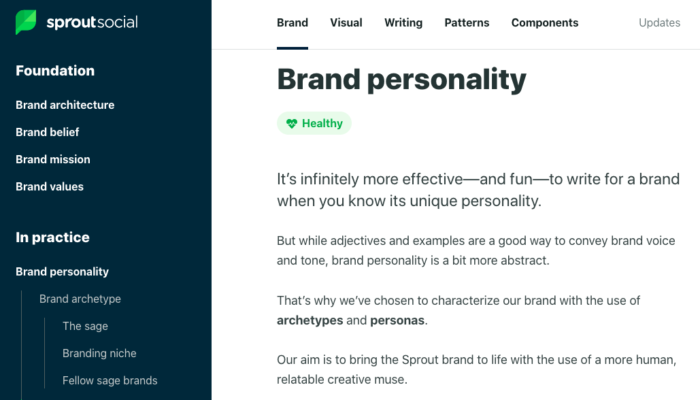
Sample brand personality guide: SproutSocial
2. Set your visual style guidelines
2.1 Logo
Set guidelines and examples on how to use your logo. Identify the correct placement, color variations, acceptable backgrounds for the logo, and the design specifications (i.e., size, color palette, fonts, etc.). Provide examples as well on proper and improper logo usage.
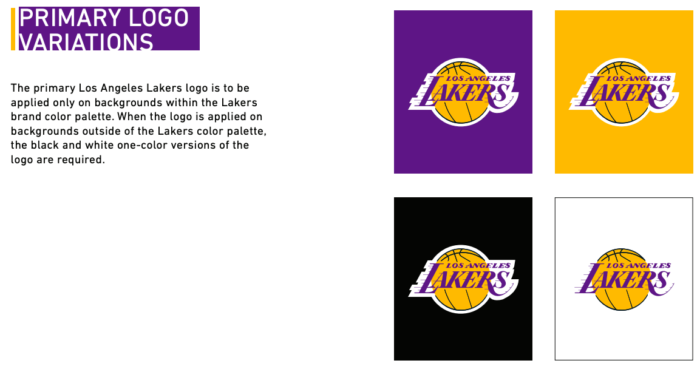
Sample logo guideline: LA Lakers
2.2 Color palette
Provide swatches for your primary and secondary brand colors in both CMYK and HEX codes, as well as RGB and PMS. Specify what is and isn’t acceptable when it comes to color combinations, usage, and backgrounds.
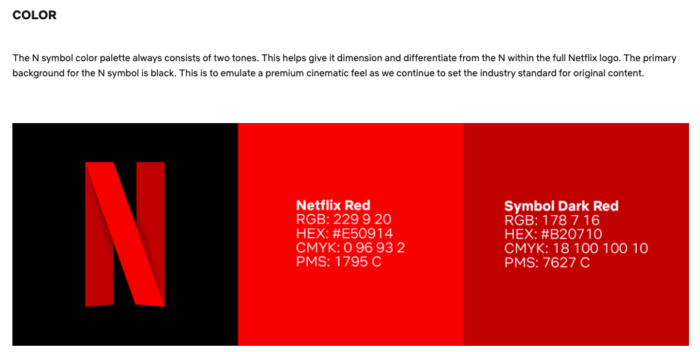
Sample color palette guideline: Netflix
2.3 Fonts and typography
Identify the fonts you use (e.g., Helvetica, Roboto, etc.) and your primary and secondary typefaces (i.e., regular, bold, italics) for your titles, subheads, body, etc. Specify the font sizes and text weights as well.
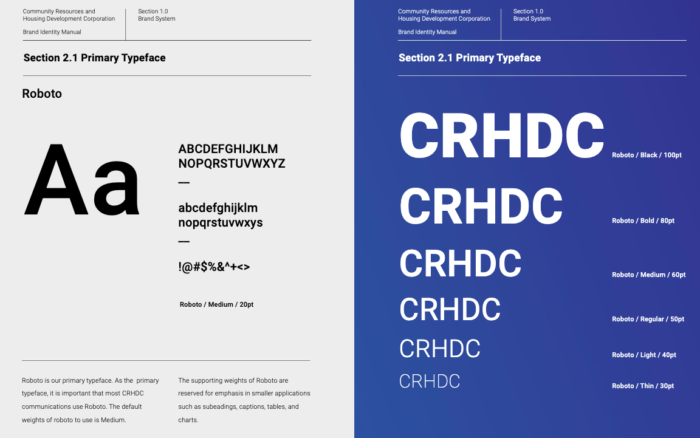
Sample font and typography guidelines: CRHDC
2.4 Iconography
Defining your style specifications for your brand icons is especially useful for web design, mobile UI/UX, or product interfaces. The coverage is similar to how you would create guidelines for the logo: the color palette, sizing, acceptable backgrounds, spacing, etc.
![]()
Sample iconography guideline: Spotify
2.5 Photography, illustrations, and imagery
Define the tone and personality you want your photography, illustrations, and imagery to portray. Specify the preferred illustration style, camera angles, tones, colors, facial expressions, and body language, to name a few. Provide clear examples of do’s and don’ts.

Sample photography and imagery guideline: Adidas
3. Specify media-specific guidelines
Specify how you want your visual elements to be used in different marketing collaterals—for example, on social media, emails, billboards, posters, stationeries/letterheads, and signages.
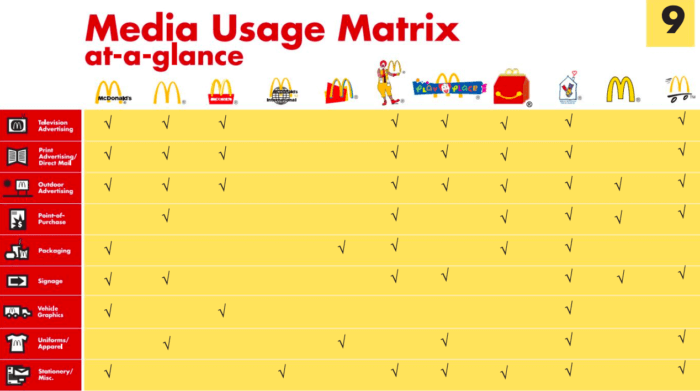
Sample media usage guideline: McDonald’s
4. Define your editorial style guide
An editorial style guide provides more details on how your brand voice, tone, personality, and messaging are articulated throughout your branding. This can be a separate guide book or can be incorporated into your brand style guide.
When crafting your editorial style guide, provide examples for each of the following:
- Your brand’s tone of voice—this is the persona of your content and describes how you want to communicate with your audience, as opposed to simply “tone” (formality and attitude) and “voice” (style of communication; e.g., playful, authoritative).
- How to craft each content type—for example, website copy, blog content, video/audio scripts, social media posts, emails, etc.
- Your target audience’s knowledge/reading level
- Words you want to use and/or avoid
- List of acronyms you use and their respective meanings
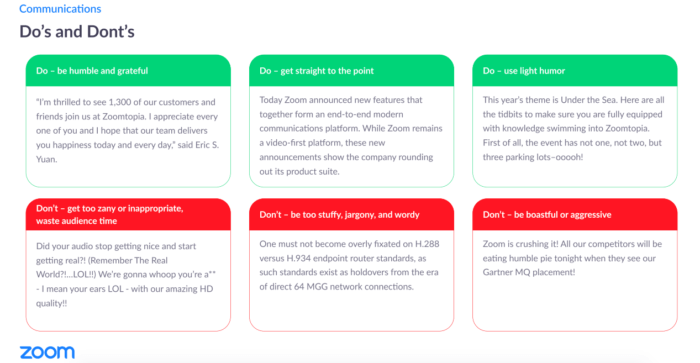
Sample editorial style guide: Zoom
Need help with your branding and design?
You can go as detailed or as minimalistic as you want when creating your brand style guide. One important thing to do, however, is to revisit your brand style guide periodically to determine whether the branding is still relevant to your audience and the trends, or if a rebranding is called for.
If you need help in designing your style guide, or if you need help in figuring out how to craft your branding strategically, Ilfusion can lend you a hand.
You can contact us at 888-420-5115, or send us an email at cr******@******on.com.
Filed in: Articles

